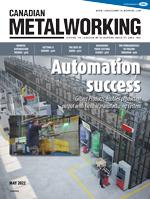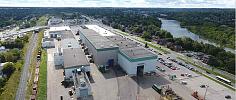Vice-President of Robotics Automation
- FMA
- The Fabricator
- FABTECH
- Canadian Metalworking
The rise of AMRs
Manufacturers must consider autonomous mobile robots to help retool operations
- By Melonee Wise
- June 6, 2022
- Article
- Automation and Software

AMR-supported manufacturing processes relegate supply shortages, fulfillment delays, and stressful working conditions to the past. Vanit Janthra/iStock/Getty Images Plus
Manufacturers are automation pioneers. Yet, many are approaching new automation, such as autonomous mobile robots (AMRs) with a high level of curiosity and caution.
That’s because AMRs have a different purpose and function than the flexible machine systems manufacturers are accustomed to using, even though AMRs are flexible automation platforms powered by intelligence software. That means risk-averse manufacturers want to be assured that AMRs can integrate easily with manufacturing systems and support larger “smart factory” or Industry 4.0 ambitions, without introducing new safety or operational risks. They ask a few questions:
- Can they sync and interact with other sensors, machines, and information systems?
- Could AMRs improve my workflow continuity between individual workcells?
- How do AMRs work compared to automated guided vehicles (AGVs) for improving the speed, efficiency, and consistency of material handling or inventory picking processes?
Some manufacturers also want to understand the potential use cases within the scheme of lean manufacturing. However, almost all manufacturers are starting to value automation as an augmentation tool that can help increase operational efficiency and output, especially when there’s a lag in workforce growth.
Making up for Lost Time and Labour
Though employment rates in the Canadian manufacturing sector are quite high compared to other industries, labour levels have remained fairly stagnant over the last five to 10 years. So as demand starts to pick back up for Canadian-produced goods, especially metal-based parts, tools, and machines, manufacturers are looking for ways to maximize their skilled labour.
They need to receive, store, produce, pack, process, and ship more than ever at a pace being dictated by a volatile market and multiple external stakeholders.
One of the easiest ways to boost productivity and compensate for the gap between customer demand and labour capacity is to remove “waste” in manufacturing processes–especially waste in transportation, motion, waiting, and skills. Arguably the easiest way to remove these types of waste is to automate material handling and inventory counts using AMRs.
Machine operators and fabricators don’t have to waste their valuable skills and time running work-in-progress materials, subassemblies, finished goods, or dunnage from one place to the next. Dynamic mobile robots can complete these repetitive tasks with ease and with very little human guidance, enabling workers to focus on more rewarding, high-value assignments.
If a worker needs materials picked up from their workstation or retrieved from another, or replenishment of floor stock materials is needed, AMR support can be requested on demand. The intelligent robot will safely navigate from one zone to the next, delivering the materials to their destination without delay. While the AMR is in transit, the worker can move on to the next task. There is no interruption in workflow. In fact, the overall manufacturing process becomes more predictable, efficient, and agile, and people’s contributions start to rise.
That last part may seem counterintuitive. If people are being asked to do less, how are they contributing more?
Simply put: They’re walking less, and getting more work done.

Automating point-to-point material movements using AMRs reduces the risk of production or fulfillment delays in any manufacturing environment. Zebra
One manufacturer we worked with to deploy AMRs said that once its machine operators no longer had to move materials manually from one area of the production facility to the next, it saw a 70 per cent boost in productivity. That extra movement proved to be a huge waste of time and labour and ultimately a bottleneck in its entire operation.
Every time an operator had to leave their station to deliver parts to the next station, the operator’s station would be sitting idle. And the receiving station would be idled until that operator arrived with the parts each time. It perpetuated a cycle of downtime that was repeated up to 40 times a day.
Could the manufacturer have hired material handlers to run the parts between stations? Sure. But most people don’t want to walk 10-plus miles a day, especially not at the speeds required of a just-in-time manufacturing operation. Plus, consistency and precision are key to increasing output and overall operational capacity no matter what you’re producing.
With AMRs, work-in-progress components can be moved between production stations with scheduled consistency as well as on-demand support, making it easier to execute JIT operations. AMRs also can move completed products to testing and quality control areas and then remain on standby to return any defective items to the line or forward them along to repair stations. Once cleared for shipping, finished goods can be transported to packout, storage, or directly to the loading dock.
In short, automating point-to-point material movements using AMRs reduces the risk of production or fulfillment delays in any manufacturing environment. It also helps reduce worker stress and make manufacturing jobs more rewarding, because people can remain focused on the most strategic, value-driven tasks–actions that can be completed only with the application of their specialized skill sets.
The Declining Cost and Growing Value of AMRs
AMRs’ positive impact on shop floor or shipping teams may be most evident to someone touring a manufacturing facility. Yet, these mobile robots demand very little support or budget from IT and operations teams, making them equally beneficial to those working behind the scenes to keep the business on track.
Technically speaking, they are flexible, cloud-based automation systems, often with the robot itself being the only on-premise infrastructure. Once the robots arrive at the manufacturer’s facility, they can be up and running within a few hours with very little on-site human support required. All that an IT or operations manager must do to onboard each robot is log into the software dashboard that serves as the control centre for the robots and make a few drag-and-drop configurations. They can map out the facility, customize each AMR’s role in the workflow, and securely integrate the mobile robots’ intelligence systems with the manufacturing execution system, warehouse execution system, and warehouse management system from any internet-enabled device.
AMRs can be virtually “trained” for each new job. They also can be reassigned to new roles by a remote management team, which can subsequently track AMR performance and refine their workflows as needed to account for changing business demands or labour levels.
If the AMRs are initially deployed for automated material transport and later needed for picking, a new workflow can be built and instructions sent to the robots via the same drag-and-drop visualization tool used during the initial setup. AMRs even can be sent to support specific events, such as an inventory count, in a highly customized schedule that accounts for the other functions they support each shift. Their flexibility, adaptability, and scalability are virtually limitless.
Manufacturers can have a secure, fully automated AMR workflow in place in a short amount of time. And if they procure the automation using the increasingly popular Robot as a Service (RaaS) model, they get outsourced technical support. This further relieves the financial and labour burden that might lower the value proposition and increase the total cost of ownership for other types of automation technologies.
Maintaining High Safety Standards
As with any type of robotics automation, worker safety must be the top priority. So, before deciding to deploy mobile robots in manufacturing environments, consider the risks.
For example, AGVs are only capable of collision avoidance, not complete obstacle avoidance like AMRs. Even though an AGV stays within well-marked travel lanes and people are trained to keep out of those areas, it won’t be able to navigate around a distracted worker who accidentally steps into its path. Without enough time to stop, a collision could occur, and even a slow-speed collision can result in a painful bruise.
And though AMRs can actively recognize and avoid people, forklifts, and even “keep out” zones as they dynamically navigate facilities, they aren’t typically recommended for some old-school, traditional machine shops given the mobility challenges and hazards present within those spaces. AMRs are more appropriate for modern machining facilities that have larger and cleaner operating environments for the robots.
In fact, AMRs are increasingly being used to transport waste materials out of production areas to ensure staging locations are free and clear of trash and recyclables, making them primary contributors to worker safety.
Safety considerations don’t lie solely in the mobile robots’ core design, intelligence, manoeuvrability, and function, though. It’s important to ensure that customized applications are also assessed and validated from a safety perspective. Are an AMR’s sensing capabilities or obstacle avoidance responsiveness affected when racks, carts, bins, and arms are attached? If so, how? And what can be done to restore full navigational capabilities? Is there a risk that loaded carts will exceed the weight limit of the base? If yes, how can it be mitigated?
New standards such as ANSI/RIA R15.08 specify the responsibilities of manufacturers, integrators, and end users when building, deploying, and adapting AMR systems and can serve as a guide when determining and mitigating safety risks.
Address Deep-rooted Operational Challenges
While manufacturers may not yet be fully versed in the technicalities of mobile robots or cloud-based robotics systems, they do know it’s in their best interest, as well as their customers’, to incorporate them. Subsequently they will work to understand the value of RaaS in the coming months and then build stakeholder confidence in the safety and security of intelligent, dynamic AMRs. Some will lean into their experiences with other automation and cloud-based business systems to extract key learnings and identify best practices. Others will turn to third-party consultants for guidance and support.
All will walk away from this transformational experience with the tools to execute well-connected, dynamically orchestrated, AMR-supported manufacturing processes that relegate supply shortages, fulfillment delays, and stressful working conditions to the past, even if labour shortages and demand surges become the new normal.
Melonee Wise is vice-president of robotics automation, Zebra Technologies, 3 Overlook Point, Lincolnshire, Ill. 60069, 877-208-7756, www.zebra.com.
About the Author

subscribe now


Keep up to date with the latest news, events, and technology for all things metal from our pair of monthly magazines written specifically for Canadian manufacturers!
Start Your Free Subscription- Industry Events
MME Saskatoon
- May 28, 2024
- Saskatoon, SK Canada
CME's Health & Safety Symposium for Manufacturers
- May 29, 2024
- Mississauga, ON Canada
DiPaolo Machine Tools Open House 2024
- June 4 - 5, 2024
- Mississauga, ON Canada
FABTECH Canada
- June 11 - 13, 2024
- Toronto, ON Canada
Zoller Open House & Technology Days 2024
- June 12 - 13, 2024
- Ann Arbor, MI




















